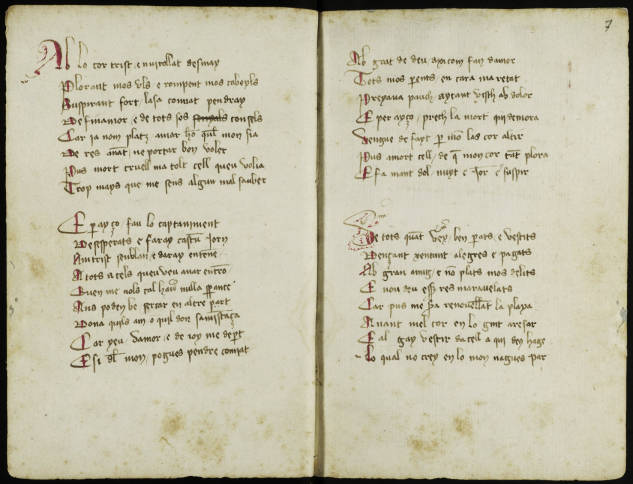Although Ab lo cor trist appears in the bibliographies of Provençal lyric poetry, it is actually a Catalan planh attributed to an anonymous female poet. The composition likely dates to the second half of the 14th century. However, the presence of an Italian caesura in line 28, a feature that fell out of use at the beginning of the 14th century, could suggest an earlier date. The poet demonstrates a deep assimilation of troubadour traditions, a common trait among Catalan poets, by incorporating traditional themes and stylistic elements. Yet, the author reworks these conventions, in a way, to make them distinctly her own.
This composition incorporates all the typical motifs of a funeral lament, though it also introduces subtle variations on some of them. In the first cobla (stanza), the poetess expresses her anguished desolation, rooted in the death of her beloved. The gestures of despair described in line 2 (plorant mos uls e rompent mos cabeyls) are characteristic of the funeral lament. Notably, the act of tearing one's hair, a gesture predominantly associated with women, is a common expression of grief. Self-pity, often conveyed through exclamations like Las! or Caitiu! —which shift the focus from the deceased to the mourner— is frequently found in planhs, whether mourning the death of a sovereign or a loved one. In the latter type, an additional element is often present: the firm resolve to renounce Love, as expressed in line 3 of Ab lo cor trist with the phrase comiat pendray.

The second cobla focuses on the woman's behaviour, characterized by her captaniment desperat, a mourning that is almost ostentatious, seemingly intended to deter new suitors.
The third cobla, though challenging to interpret due to the faulty transmission of the manuscript, includes an invocation of death. Previously cursed and scorned as mort cruell, death is now desired as a release from the torment of love.
The fourth cobla appears to transcend the conventional rhetoric of the planhs by giving voice to the woman's subjectivity and her memories. Here, it is not so much envy for the happiness of others that stands out, but rather the recollection of her beloved. The passage highlights her clothing and well-groomed appearance: anant me·l cor en lo gint aresar / e al gai vestir d’acell.
The fifth cobla introduces the theme of abandoning Love and the impossibility of finding another man equal to the deceased. The poetess confines the laudatio funebris, a key element in funeral laments, to lines 30-38. Typically, the authors of planhs emphasize the loss to the entire community of a person with exceptional qualities. In this instance, though the chosen lexicon is entirely conventional —valor, onor, franqueza, ardor— the despair over the loss of such a valuable man appears to affect only the poetess. She ultimately justifies her renunciation of Love by the impossibility of finding another suitor who could compare to her beloved.
The sorrowful wish for death, expressed in the third cobla, eventually gives way to resignation in the face of the impossibility of ending her own life. This resignation marks the conclusion of the composition, as the woman describes herself as already dead. Addressing her beloved through the senyal-invocació Mon dolç amich ("My sweet friend"), she declares: "Even if no one comes to bury me, I am already completely dead”.
(English translation by Pol Bridgewater)
